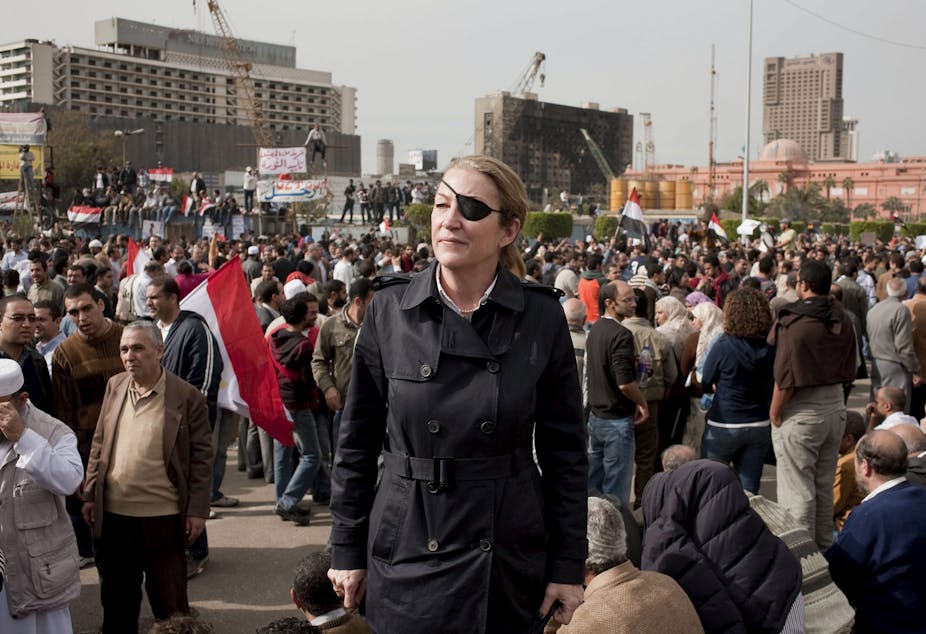The news coming out of the ongoing conflict in Syria is tragic and, for many, too horrible to look at for long. While the reportage is appreciated, one can’t help but wonder whether it would be different if foreign correspondent Marie Colvin and the other 32 journalists killed there in 2012 were still alive and reporting on it.
Questions surrounding Colvin’s death remain unanswered. Was the bombing of the house Colvin was working from a justifiable accident, or was she targeted as part of a deliberate strategy of killing the messengers? If she was, then a war crime was committed, and someone should be tried in either a national court or the International Criminal Court (ICC) for committing it.
But there has not yet been sustained pressure from the world’s media calling for an investigation and trial – and this is odd considering how powerful a united campaign by the world’s media could be. So where is the journalistic will to call for justice?
Previous campaigns, previous victories
Concerted campaigns by media advocates have, in the past, yielded legal recognition of journalists in warzones. For example, clauses protecting embedded journalists were included in the Lieber Code of 1863, governing the Union armies in the US Civil War. In 1927, the League of Nations endorsed resolutions on the treatment of foreign journalists, and the protection of journalists was hotly debated leading up to the adoption of the international humanitarian law (IHL) Additional Protocols in 1977.
Media organisations including the Committee to Protect Journalists (CPJ), the International Federation of Journalists (IFJ), Reporters Without Borders (RSF) and the Press Emblem Campaign (PEC) run permanent campaigns calling for “something” to be done to reduce the death toll of journalists.
However, a lack of consistency in what they are calling for and who they are calling on, as well as a lack of ongoing support from the industry in the form of publicity sees most of their work languish below the radar of public perception and limits its political clout.
The PEC: a divisive campaign
The PEC is a prime example of a distracting and divisive campaign. In 2007, the Geneva-based group launched a proposed international convention on the protection of journalists in times of war, including the adoption of a protected press emblem. Its rationale is that the provisions in IHL for the protection of journalists are “ineffective”.
The PEC claims that it has the support of 50 journalism organisations worldwide, and in late 2012 it won a Swiss Press Club award for “defending journalists across the globe”. However, a closer look at the provisions the organisation is hoping most countries will ratify reveals them to be pie-in-the-sky.
These provisions include requiring military forces to give journalists prior warning of attacks (based on an assurance that journalists would maintain confidentiality while fleeing); the creation of an international commission to investigate breaches; and the funding of an insurance scheme.
The CPJ distanced itself from the PEC early on, declaring in 2005 that the adoption of a universal press emblem is undesirable for a number of reasons, including that it would “require a licensing entity to determine who is and is not a journalist”.

However, the main problem with the PEC is that it is based on the assumption that killing a media worker should be a more heinous crime than killing a teacher, doctor, grandmother, or any other civilian.
More prosecutions, not more laws
By contrast, the primary distinction IHL makes between people in conflict zones is combatants versus non-combatants. This means that a soldier can kill a soldier without it being murder. However, if anyone else dies as “collateral damage”, it must be successfully argued that those deaths were justifiable in the face of the military gain achieved - using the legal principle of “proportionality” - to evade conviction, if the case gets to court.
All other distinctions in IHL hone back to the combatant/non-combatant distinction. For example, if a conflict is deemed to be international and a journalist is embedded in a military force - and that journalist is captured by an enemy force - then they have the right to Prisoner of War status (like a combatant). In all other cases, journalists are granted the greater protection of being deemed to be civilians, who are non-combatants.
It is minutiae like this that makes tweaking the laws a confusing topic to cover in the media, but the bottom line is simple. If there was more international impetus - backed by funding - to prosecute all breaches of the Geneva Conventions and Additional Protocols in both national courts and the ICC, then the slow struggle to end impunity for the killing of journalists in warzones would move faster.
This may constitute a form of advocacy journalism, but it advocates for a cause that not only has self-interest benefits of protecting media workers, but also helping to protect civilians everywhere. That’s an easy thing to argue as a universal good.

